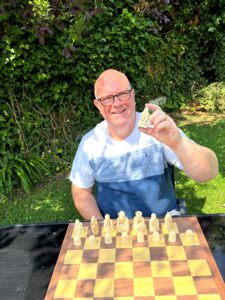
Checkmate or Settlement? What Chess Can Teach Us About ADR
After decades in mediation and arbitration – with a chessboard never far from my desk – I’ve discovered something unexpected: the ancient game of kings mirrors the modern practice of Alternative Dispute Resolution in remarkable ways.
What began a bit of fun has evolved into a powerful framework for understanding ADR. The strategic complexity, the interplay of different roles, the careful balance of patience and decisive action – chess offers the perfect lens through which to examine how disputes actually get resolved.
The Game Within the Game
ADR can feel like navigating a labyrinth. Mediation, arbitration, adjudication, early neutral evaluation – each process has its own rhythm, its own strategic purpose. Yet beneath this complexity lies a familiar pattern, one that anyone who’s ever moved a pawn or sacrificed a bishop instinctively understands.
Let me show you the board.

The King – The Parties in Dispute
Every chess game revolves around two vulnerable Kings, and every ADR process centres on the disputing parties. Like the King, parties often find themselves constrained, able to move only cautiously, one step at a time. They’re simultaneously the most important figures on the board and the most dependent on others for protection and strategic guidance.
The King’s limited mobility isn’t weakness, it’s wisdom. Parties in dispute need time to consider their moves, to understand the consequences of each decision. Rush them, and the game ends in disaster.

The Queen – The Commercial Mediator
Meet the board’s most versatile player. A skilled commercial mediator, like the Queen, can move in any direction the situation demands. One moment they’re facilitating direct dialogue, the next they’re conducting delicate shuttle diplomacy between separate rooms. They adapt, they pivot, they find pathways others can’t see.
But the crucial distinction is that the Queen doesn’t win the game by taking the opponent’s King. Instead, she creates the conditions where resolution becomes possible. The best mediators, like the best Queens, know when to advance and when to retreat, when to apply pressure and when to provide space.

The Rook – The Arbitrator
Straight lines. Clear rules. Decisive movement. The Rook embodies everything we value in arbitration: authority, structure, and finality. When parties need certainty rather than creativity, when legal principles must be applied rather than bent, the Rook steps forward.
Arbitrators move through disputes with the same methodical precision as Rooks navigate the board. No diagonal compromises, no Knight’s-move creativity – just direct, binding decisions that cut through the complexity.

The Bishop – The Specialist Mediator
Bishops are diagonal thinkers, moving within their chosen domain with precision and insight. They represent the specialist mediators – those with deep expertise in construction, employment, family law, or any field where technical knowledge matters as much as process skills.
Like Bishops, these practitioners operate within their sphere of influence, but within that sphere, they’re invaluable. They see angles others miss, understand the terrain in ways that generalists cannot.

The Knight – The Transformative Mediator
The Knight’s L-shaped movement defies conventional logic – two squares forward, one to the side, leaping over obstacles that would stop other pieces. This perfectly captures the approach of transformative and restorative mediators.
These practitioners don’t march directly toward settlement. Instead, they leap into the emotional heart of the conflict, working with empathy, empowerment, and relationship repair. Their path to resolution isn’t linear, but their impact can be profound.

The Pawn – ADR Support Staff
Never underestimate the pawns. Case managers, administrators, and junior practitioners form the backbone of every ADR process. They may seem limited in their movement, but they’re the ones who actually advance the game, one careful step at a time.
And like pawns that reach the far end of the board, support staff can transform – like me – becoming fully qualified mediators, arbitrators, or specialists in their own right. The journey from pawn to Queen is one of ADR’s most rewarding progressions.
Advanced Maneuvers
The chess metaphor extends beyond individual pieces to the strategic moves that define both games:
Castling represents the confidentiality agreements that protect both sides, allowing for the strategic repositioning necessary for meaningful dialogue.
Stalemate, or as mediators may call it – deadlock – captures those frustrating mediations where neither party can move forward productively – nobody loses, but nobody wins either.
En passant is that unexpected mid-arbitration settlement – rare, often misunderstood, but perfectly legitimate when it happens.
Check signals interim measures or urgent applications – a sharp reminder that one side’s position is under immediate threat, though the game continues.
Promotion reflects the beautiful arc of professional development in ADR, where dedicated practitioners evolve from support roles to specialist expertise.
The Endgame
Understanding ADR through chess reveals a fundamental truth: success isn’t just about following rules, it’s about understanding roles, recognising patterns, and thinking several moves ahead.
Every piece on the board has value, every role in ADR serves a purpose. The key is knowing when to deploy each one, how they work together, and what endgame you’re actually pursuing.
Because the thing about both chess and dispute resolution is that not every game has to end in checkmate. Sometimes the wisest strategy is knowing when to offer a draw, when to shake hands, when to recognise that the real victory lies not in defeating your opponent but in finding a path forward that serves everyone’s interests.
The next time you’re approaching a conflict, whether as a party, an advisor, or a neutral, think about the board. Consider which piece you are, what moves are available, and what endgame serves the broader game.
After all, the best resolution isn’t always the most aggressive one. Sometimes, the smartest move is simply to settle.
